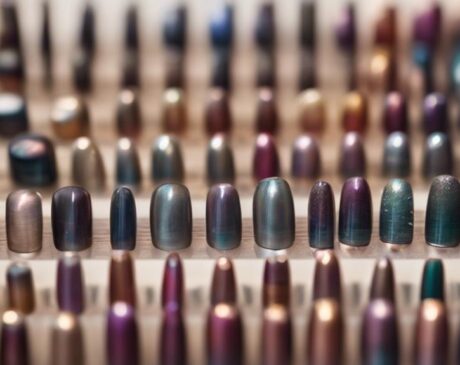How Many RPM Is a Good Nail Drill?

The ideal RPM for a nail drill varies depending on the task. For natural nails, 4,000 to 15,000 RPM is recommended. Lower RPM is gentler, while higher speeds are efficient for nail enhancements. Adjusting RPM based on the service being performed helps ensure precision and safety. For gel applications, 2,000 to 5,000 RPM is optimal, preventing overheating. Choosing the right RPM involves considering skill level and comfort. Experimenting with different settings enhances results. Understanding the importance of RPM in nail drills is key to achieving desired outcomes.
Key Takeaways
- Optimal RPM for a good nail drill ranges between 4,000 to 15,000 rotations per minute.
- Lower RPM for precision tasks, higher for efficiency in material removal.
- Balance RPM for nail health and desired results.
- Experiment with RPM settings to find the ideal speed for each task.
- Choose RPM based on the nail service being performed.
Importance of RPM in Nail Drills

The RPM (Revolutions Per Minute) of a nail drill is a crucial factor that determines its efficiency and performance in various nail care tasks. A high RPM is essential for quickly and effectively shaping, filing, and buffing nails, especially in professional settings where time is of the essence. The RPM directly affects the speed at which the drill operates, impacting the precision and smoothness of the nail work performed.
For intricate nail art designs or delicate tasks such as cuticle care, a nail drill with adjustable RPM settings offers versatility and control. Lower RPM settings can provide gentle care for sensitive areas, while higher RPM settings are ideal for more robust nail treatments. Moreover, understanding the relationship between RPM and torque is vital. Torque is the rotational force produced by the nail drill, influencing its power to handle different nail types and textures.
Innovations in nail drill technology continue to focus on optimizing RPM capabilities to meet the evolving demands of nail technicians and enthusiasts, emphasizing the importance of this factor in achieving precise and professional nail care results.
Understanding RPM Range
When considering the RPM range of a nail drill, it's crucial to understand how different speeds can impact nail health. By exploring the relationship between RPM and potential nail damage, users can make informed decisions about the optimal speed for their nails. Selecting the right RPM is key to achieving the desired results without compromising the health and integrity of the nails.
RPM for Nail Health
Maintaining nail health involves understanding the appropriate RPM range for nail drills. When it comes to RPM for nail health, finding the right balance is crucial. Operating at an excessively high speed can lead to damage and weakening of the nails, while a very low speed might not provide the necessary precision. It is recommended to stay within the range of 2,000 to 8,000 RPM for general nail care. However, for more intricate nail art or detailed work, a higher RPM of up to 20,000 may be required. Always consider the type of nail service being performed and adjust the RPM accordingly to ensure both efficiency and nail health.
| RPM Range | Recommended Use |
|---|---|
| 2,000-4,000 | General nail care |
| 4,000-8,000 | Nail shaping and smoothing |
| 8,000-12,000 | Cuticle maintenance |
| 12,000-20,000 | Nail art and detailed work |
RPM Vs. Nail Damage
Understanding the appropriate RPM range is key to preventing nail damage when using a nail drill. The RPM (Revolutions Per Minute) at which a nail drill operates directly impacts the safety and health of the nails during manicure or pedicure procedures. Higher RPMs can lead to overheating and friction, potentially causing damage to the nail bed or cuticles. On the other hand, too low RPMs may not provide efficient results, leading to extended drilling time which can weaken the nails. Therefore, striking a balance and selecting the optimal RPM range is crucial for maintaining nail health while achieving desired results. By staying within the recommended RPM range, users can effectively utilize nail drills without compromising the integrity of their nails.
Optimal RPM Selection
Selecting the appropriate RPM range is essential for ensuring the safe and effective use of a nail drill while maintaining nail health and achieving desired results. The optimal RPM selection varies based on the specific task at hand. For delicate tasks like shaping or buffing the nails, a lower RPM between 5,000 to 8,000 is recommended to prevent damage to the nail bed. However, for tasks that require more power such as removing acrylics or gels, a higher RPM between 15,000 to 25,000 may be more suitable. Understanding the RPM range allows for precision and control during nail treatments, ultimately leading to professional results. By matching the RPM to the task, users can enhance their nail care routines and elevate the overall experience.
Low Vs. High Rpm: Pros and Cons
Achieving the optimal performance from a nail drill involves carefully considering the advantages and disadvantages of operating at low versus high RPM. When deciding between low and high RPM settings for your nail drill, it's essential to weigh the following factors:
- Precision: Low RPM settings offer greater precision, making them ideal for detailed work.
- Efficiency: High RPM settings are more efficient for quickly removing bulk material.
- Heat Generation: Low RPM reduces heat generated, which can help prevent damage to the nail.
- Control: High RPM may provide less control, especially for beginners.
- Finishing: Low RPM is better suited for finishing touches and shaping nails smoothly.
RPM Recommendations for Acrylic Nails

When it comes to acrylic nails, finding the ideal RPM for your nail drill is crucial for achieving the best results. Factors such as the thickness of the acrylic and the skill level of the user can influence the recommended RPM. Additionally, prioritizing safety considerations when adjusting the RPM is essential to prevent damage to the natural nail and surrounding skin.
Ideal RPM for Acrylic
Acrylic nails typically require a nail drill with an ideal RPM range to ensure precise and efficient shaping and filing. When working on acrylic nails, the ideal RPM for the nail drill should be considered carefully to achieve the best results. Here are some key points to keep in mind when determining the ideal RPM for acrylic nails:
- Start at a lower RPM: Begin shaping and filing at a lower RPM to prevent overheating the acrylic.
- Gradually increase RPM: Increase the speed gradually to find the optimal RPM for shaping without causing damage.
- Consider the thickness: Adjust the RPM based on the thickness of the acrylic nails.
- Maintain a consistent speed: Keep a steady hand and maintain a consistent RPM for uniform results.
- Experiment for best results: Test different RPM settings to find what works best for your technique and desired outcome.
Factors Affecting RPM
Factors influencing the ideal RPM for acrylic nail drills include the type of acrylic being used, the desired nail shape, and the experience level of the user. Different types of acrylic vary in density and hardness, requiring varying RPMs for efficient shaping and filing. For instance, softer acrylics may require lower RPM settings to prevent over-filing or damage, while harder acrylics may need higher RPMs for effective shaping. The desired nail shape also plays a role, with intricate designs often necessitating more precise control at lower speeds. Additionally, the user's experience level is crucial; beginners may benefit from starting at lower RPMs to gain proficiency and avoid accidents, while seasoned professionals may prefer higher speeds for faster work without compromising precision.
Safety Considerations With RPM
To ensure safe and effective use of acrylic nail drills, it is important to consider the recommended RPM settings tailored to the specific characteristics of the acrylic material being worked on. When working with acrylic nails, the following safety considerations with RPM should be taken into account:
- Start Slow: Begin at a lower RPM and gradually increase as needed.
- Monitor Heat: Higher RPMs can generate heat, so ensure proper cooling to prevent damage.
- Use Light Pressure: Applying excessive pressure at high RPMs can cause damage to the nail.
- Invest in Quality Bits: High-quality drill bits can work effectively at lower RPMs.
- Practice Regular Maintenance: Keep your drill clean and well lubricated to maintain optimal RPM performance.
RPM Guidelines for Natural Nails

A recommended RPM range for natural nails during nail drilling procedures is crucial to maintaining nail health and preventing damage. When working on natural nails, it is generally advised to operate the nail drill at a speed ranging from 4,000 to 15,000 rotations per minute (RPM). This range allows for efficient shaping, filing, and light buffing without causing harm to the natural nail plate. Lower RPM settings are suitable for gentle shaping and refining the edges of the nails, while higher speeds can be utilized for quicker filing and removing product during nail enhancements.
Operating within the recommended RPM range for natural nails ensures precision and control during the nail service, reducing the risk of over-filing or causing heat build-up that can damage the nails. This guideline promotes a balance between efficiency and nail safety, catering to the needs of clients who value both speed and nail health. By adhering to these RPM guidelines, nail technicians can deliver quality services while prioritizing the well-being of their clients' natural nails.
Adjusting RPM for Different Tasks
When performing various tasks with a nail drill, adjusting the RPM settings appropriately is essential for achieving optimal results and ensuring the safety of the nail plate. Different tasks require different RPM settings to deliver the best outcomes. Here are some tips for adjusting RPM for various nail drill tasks:
- Buffing: Lower RPM settings are ideal for buffing nails to avoid causing damage or heat buildup.
- Shaping: Moderate to high RPM settings work well for shaping nails efficiently without causing discomfort.
- Cuticle Care: Lower RPM settings are recommended for gentle cuticle work to prevent injury.
- Removing Gel Polish: Higher RPM settings are useful for efficiently removing gel polish without excessive friction.
- Smoothing Rough Edges: Moderate RPM settings can help smooth rough edges effectively while maintaining precision.
RPM for Gel Nail Applications

For achieving flawless gel nail applications, determining the optimal RPM setting on a nail drill is crucial. Gel nails require precision and care during application, making the choice of RPM setting a critical factor in achieving professional results. Typically, for gel nail applications, a lower RPM setting ranging from 2,000 to 5,000 is recommended. This lower speed helps prevent overheating of the gel polish, which could lead to inconsistencies in the application and potential damage to the natural nail.
At a lower RPM, nail technicians have more control over the process, allowing for smoother application and shaping of the gel without causing unnecessary stress to the nail plate. Additionally, the slower speed enables better blending of the gel, resulting in a more even and natural-looking finish. Experimenting with different RPM settings within this range can help nail technicians find the ideal speed that suits their technique and the specific gel products being used. Ultimately, the right RPM setting contributes significantly to the overall quality and longevity of gel nail applications.
Choosing the Right RPM for You
Determining the suitable RPM for your nail drill is essential for achieving precise and professional results in your nail applications. To choose the right RPM for you, consider the following factors:
- Skill Level: Higher RPMs may be suitable for experienced users who can control the drill effectively.
- Nail Type: Adjust the RPM based on whether you are working on natural nails or artificial enhancements.
- Precision Needed: Lower RPMs are ideal for detailed work, while higher RPMs are better for bulk removal.
- Comfort: Select an RPM that feels comfortable and allows you to work without straining.
- Experimentation: Don't be afraid to experiment with different RPM settings to find what works best for you and the specific nail application.
Frequently Asked Questions
Can a Nail Drill With Lower RPMS Still Be Effective for Professional Nail Services?
A nail drill with lower RPMs can still be effective for professional nail services. The key lies in the quality of the drill's construction, precision, and versatility. By choosing a well-designed model, nail technicians can achieve optimal results regardless of RPM.
Are There Any Safety Concerns Associated With Using a High RPM Nail Drill?
High RPM nail drills can pose safety concerns, such as heat generation leading to burns or nail damage if not used properly. It is crucial to prioritize safety by ensuring proper training, using appropriate techniques, and selecting the right RPM for the task at hand.
How Does the RPM of a Nail Drill Affect the Durability of the Nail Enhancements?
The RPM of a nail drill significantly impacts the durability of nail enhancements. Higher RPMs can lead to excessive heat generation, potentially compromising the bond between the nail enhancement and the natural nail. Optimal RPM levels ensure a balance between efficient work and preservation of quality.
Can Using a Nail Drill at the Wrong RPM Cause Damage to the Natural Nail?
Utilizing a nail drill at an inappropriate speed can indeed harm the natural nail. Incorrect RPM settings may lead to excessive heat generation, potential burns, or even structural damage. Precision in adjusting RPM is crucial to avoid such repercussions.
Is It Possible to Adjust the RPM of a Nail Drill for Specific Nail Art Techniques?
Adjusting the RPM of a nail drill for specific nail art techniques is essential in achieving precision and desired results. By customizing the speed, nail technicians can optimize control and performance, enhancing the quality of their work.




